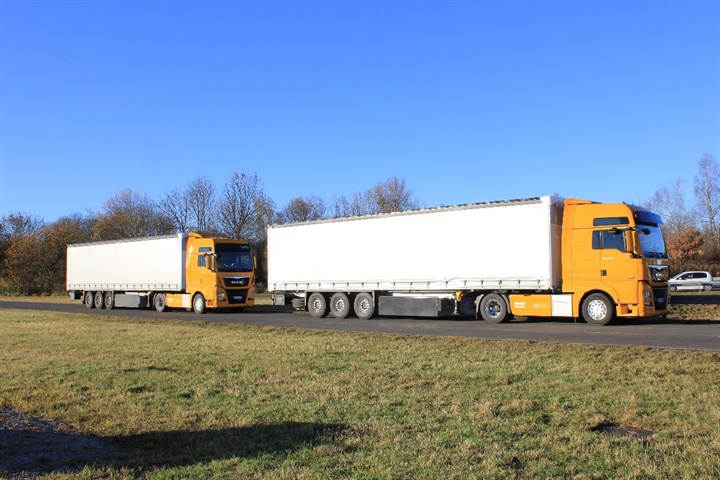Your July 13 Pre-Trip: Face recognition software in trucking

Here are five things worth knowing today:
read more

Here are five things worth knowing today:
read more

Bestpass has launched a new web portal at my.bestpass.com to help its customers better manage their fleets, as well as to access advanced tolling and trucking analytics and reporting.
According to the company, the portal provides on-demand reporting; self-serve transponder ordering; and vehicle, license plate and transponder management. New features include:
read more

Vnomics Corp. announced it has received notice that its second U.S. Patent for its True Fuel standalone fuel optimization solution has been approved.
read more
Photo courtesy of VNG.
">Photo courtesy of VNG.
">Oklahoma has reached a milestone of having at least one compressed natural gas (CNG) station every 100 miles along its interstates in a private-public partnership that began in 2011, according to an announcement from NGVAmerica.
Gov. Mary Fallin, who initially set the goal, recently joined CNG retailers OnCue Express, Love's Travel Stops, Sparq Natural Gas, Oklahoma Natural Gas and Tulsa Gas Technologies with other CNG proponents to celebrate the achievement at the OnCue Express CNG station in Billings, Okla.
Fallin's 2011 Oklahoma First Energy Plan called for the establishment of a network of CNG infrastructure along highways and interstates. The first goal was to have at least one CNG station every 100 miles along interstates by the end of 2015.
"Gov. Fallin has been an exemplary leader in advancing the use of clean-burning natural gas as a transportation fuel," said Matthew Godlewski, NGVAmerica's president. "Oklahoma sets an impressive example for other states looking to transition to our country's abundant supply of natural gas."
Related: Oklahoma Gov. Signs NGV Conversion Bill
Follow @HDTrucking on Twitter

Missouri Governor Jeremiah W. Nixon has vetoed HB1733, a bill that would have established a pilot program for testing automated long-haul trucks using platooning technology.
In a letter explaining his veto, Gov. Nixon said that one of the reasons for his veto was that establishing a pilot program for testing platooning vehicles on Missouri highways could put the public at risk.
He specifically referenced an accident involving a self-driving Tesla car that lead to the death of an Ohio man as an example of the danger automated driving technology could pose.
“Automated driving technology has advanced significantly within the last several years, however the long term safety and reliability of this technology remains unproven,” Nixon stated. “That fact was tragically highlighted with the recent fatality involving a self-driving passenger vehicle.”
In the May 7 incident, a man Joshua Brown was killed while using the Autopilot feature of his Tesla Model S. A white tractor-trailer made a left turn in front of the Tesla at an intersection, but the autopilot failed to "see" the vehicle and did not brake. It is believed that the Autopilot's cameras were unable to recognize the white trailer against a brightly lit sky.
Gov. Nixon says that he felt that platooning could pose an even greater risk to the public because it requires multiple large trucks to travel in tandem with little separation and synchronized braking and acceleration.
“The risks associated with automated vehicles are even greater considering the size of long-haul trucks and the catastrophic damage that could occur if the technology failed,” he stated. “Using Missouri highways as a testing ground for long-haul trucks to deploy this unproven technology is simply a risk not worth taking at this time.”
Related: White Trailer Proved Invisible to Tesla's Autonomous System
Follow @HDTrucking on Twitter

There are many things you can do to keep OSHA happy. But the first thing you need to do is to keep yourself, your employees, boss or owner happy.
The first thing you many want to do is take a camera around the shop with you and take a couple hundred pictures. That's not hard today with a digital camera. Then, once you take those pictures, create a slideshow, and you will see that you have plenty to do.
Here are some basic things to consider:
read more
Photo via Love's Travel Stops
">Photo via Love's Travel Stops
">The Love's Travel Stop in Guthrie, Okla., off Interstate 35, is now offering Fast-Fill compressed natural gas for heavy-duty trucks, the company announced.
The recently acquired Trillium CNG, now a part of the Love's family of companies, will maintain the CNG fuel systems at the travel stop and maintain reliable service.
“Trillium as the CNG affiliate of Love's strengthens the experience we can offer our Customers,” said Bill Cashmareck, general manager of natural gas for Love's. “Trillium is the best in the industry for CNG systems maintenance and their expertise ensures operations will remain in top condition for years to come. Meanwhile, customers can expect the same level of service Love's stores are known for.”
Love's added CNG to the Gurthrie location due to the heavy traffic on Interstate 35 40 miles north of Oklahoma City. It joins a string of Fast-Fill CNG Love's locations along Interstate 35, including fueling stations in Ardmore, Okla., Fort Worth and San Antonio, Texas.
Guthrie is Love's 18th overall location to offer Love's Fast-Fill CNG. Together Love's and Trillium own 65 CNG locations and operate nearly 100 additional locations.
“As Love's and Trillium move forward together, we will keep our focus on designing and building high-quality CNG stations, both for ourselves and others. Trillium will also keep providing maintenance services for existing locations, and for others in the CNG market,” said Cashmareck.
Related: Trillium CNG Officially Joins Love's Travel Stops
Follow @HDTrucking on Twitter